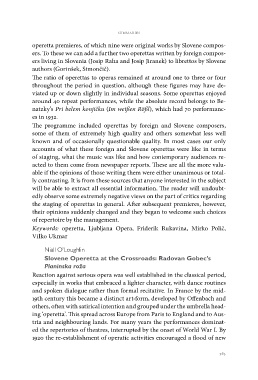Page 565 - Weiss, Jernej, ur./ed. 2021. Opereta med obema svetovnima vojnama ▪︎ Operetta between the Two World Wars. Koper/Ljubljana: Založba Univerze na Primorskem in Festival Ljubljana. Studia musicologica Labacensia, 5
P. 565
summaries
operetta premieres, of which nine were original works by Slovene compos-
ers. To these we can add a further two operettas written by foreign compos-
ers living in Slovenia (Josip Raha and Josip Jiranek) to librettos by Slovene
authors (Gorinšek, Simončič).
The ratio of operettas to operas remained at around one to three or four
throughout the period in question, although these figures may have de-
viated up or down slightly in individual seasons. Some operettas enjoyed
around 40 repeat performances, while the absolute record belongs to Be-
natzky’s Pri belem konjičku (Im weißen Rößl), which had 70 performanc-
es in 1932.
The programme included operettas by foreign and Slovene composers,
some of them of extremely high quality and others somewhat less well
known and of occasionally questionable quality. In most cases our only
accounts of what these foreign and Slovene operettas were like in terms
of staging, what the music was like and how contemporary audiences re-
acted to them come from newspaper reports. These are all the more valu-
able if the opinions of those writing them were either unanimous or total-
ly contrasting. It is from these sources that anyone interested in the subject
will be able to extract all essential information. The reader will undoubt-
edly observe some extremely negative views on the part of critics regarding
the staging of operettas in general. After subsequent premieres, however,
their opinions suddenly changed and they began to welcome such choices
of repertoire by the management.
Keywords: operetta, Ljubljana Opera, Friderik Rukavina, Mirko Polič,
Vilko Ukmar
Niall O’Loughlin
Slovene Operetta at the Crossroads: Radovan Gobec’s
Planinska roža
Reaction against serious opera was well established in the classical period,
especially in works that embraced a lighter character, with dance routines
and spoken dialogue rather than formal recitative. In France by the mid-
19th century this became a distinct art-form, developed by Offenbach and
others, often with satirical intention and grouped under the umbrella head-
ing ‘operetta’. This spread across Europe from Paris to England and to Aus-
tria and neighbouring lands. For many years the performances dominat-
ed the repertories of theatres, interrupted by the onset of World War I. By
1920 the re-establishment of operatic activities encouraged a flood of new
563
operetta premieres, of which nine were original works by Slovene compos-
ers. To these we can add a further two operettas written by foreign compos-
ers living in Slovenia (Josip Raha and Josip Jiranek) to librettos by Slovene
authors (Gorinšek, Simončič).
The ratio of operettas to operas remained at around one to three or four
throughout the period in question, although these figures may have de-
viated up or down slightly in individual seasons. Some operettas enjoyed
around 40 repeat performances, while the absolute record belongs to Be-
natzky’s Pri belem konjičku (Im weißen Rößl), which had 70 performanc-
es in 1932.
The programme included operettas by foreign and Slovene composers,
some of them of extremely high quality and others somewhat less well
known and of occasionally questionable quality. In most cases our only
accounts of what these foreign and Slovene operettas were like in terms
of staging, what the music was like and how contemporary audiences re-
acted to them come from newspaper reports. These are all the more valu-
able if the opinions of those writing them were either unanimous or total-
ly contrasting. It is from these sources that anyone interested in the subject
will be able to extract all essential information. The reader will undoubt-
edly observe some extremely negative views on the part of critics regarding
the staging of operettas in general. After subsequent premieres, however,
their opinions suddenly changed and they began to welcome such choices
of repertoire by the management.
Keywords: operetta, Ljubljana Opera, Friderik Rukavina, Mirko Polič,
Vilko Ukmar
Niall O’Loughlin
Slovene Operetta at the Crossroads: Radovan Gobec’s
Planinska roža
Reaction against serious opera was well established in the classical period,
especially in works that embraced a lighter character, with dance routines
and spoken dialogue rather than formal recitative. In France by the mid-
19th century this became a distinct art-form, developed by Offenbach and
others, often with satirical intention and grouped under the umbrella head-
ing ‘operetta’. This spread across Europe from Paris to England and to Aus-
tria and neighbouring lands. For many years the performances dominat-
ed the repertories of theatres, interrupted by the onset of World War I. By
1920 the re-establishment of operatic activities encouraged a flood of new
563


